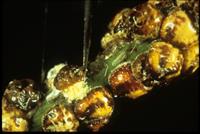|
|
|
|
|

Caption: Lecanium scale
Photo by: R.S. Byther
|
|
Scale insects
(revision date: 5/4/2022)
Use Integrated Pest Management (IPM) for successful pest management.
Biology
Several species of scale insects may infest indoor plants. They are quite small, usually ranging from 1/16" to 1/8" in diameter. The scale is actually a hard shell which protects the female insect and eggs from physical and chemical damage. The shell may be brown, black or grayish with various markings on it. It can be flattened or rounded in profile, or look like an oyster shell (oystershell scale). The insects themselves are soft-bodied and feed by sucking sap from the plant. Adults do not move around the plant once they are established and form the scale covering. Young scales ("crawlers") lack the hardened shell and are more mobile. The crawlers are usually grayish to brownish in color, flattened, and smaller than adults. Damage caused by scale insects may resemble that of aphids, with wilting, yellowing, and overall decline of the plant common. Heavy scale infestations can kill plants. Some scale species produce large amounts of honeydew, coating leaves and nearby surfaces with a shiny, sticky residue. Black sooty mold may grow on the honeydew. While the mold is not a direct threat to the health of the plant, it is unsightly and may become a problem on household surfaces.
|
|
|
Management Options
Non-Chemical Management
- Some naturally-occurring plant structures may resemble scale insects. Scrape gently with a knife and examine the results with a magnifying glass: plant tissues will appear green or creamy white beneath the shell-like structure, while scale shells will lift off to reveal either a 6-legged insect or a cottony mass with eggs or tiny crawlers.
- Do not move plants inside from outdoors. If you must move plants indoors, they should be quarantined (for example, in a spare bedroom) and kept isolated from other indoor plants for about a month. During this time, regularly inspect the quarantined plants for pest problems. Treat pest problems as necessary and continue isolation until the plants are “clean” for at least one full month before integrating them with the rest of your plant collection.
- Quarantine and monitor newly purchased plants or plants from your collection which have become infested with pests.
- Heavily infested plants may be too damaged to save. Get rid of them!
- Prune or pinch off heavily infested leaves and shoots.
- Scales may be wiped, scraped, or rubbed off. Wiping with cotton swabs or balls moistened in rubbing alcohol may help control light infestations, especially the crawlers. Excessive alcohol use may harm some plants. If you are concerned, test on a single leaf and wait a few days to check for damage.
- Sooty mold may be wiped or washed off leaf surfaces with lukewarm water. Clean other household surfaces with a damp cloth or appropriate cleaner.
- Do not overfertilize. Scale insects thrive on plants with higher nitrogen levels. Consider switching to a lower-nitrogen fertilizer or a slow-release product.
Select non-chemical management options as your first choice!
Chemical Management
Since many chemical control measures are most effective on the crawler stage, close monitoring of plants with a magnifying lens is essential for good control. Products containing systemic pesticides such as imidacloprid are effective against both crawlers and adults feeding on green tissues but not on adults feeding on woody tissues such as trunks. When practical, take houseplants outdoors to a shaded location before applying chemical controls. Allow sprays to dry thoroughly before returning plants indoors.
Chemical controls are NOT RECOMMENDED on edible plants (i.e. herbs, salad greens, etc.) grown indoors for culinary use.
If you choose to use a pesticide, some examples of products that are legal in Washington are listed below. Some products are labeled for just INDOOR or just OUTDOOR use, or may allow both uses. Be sure to choose a product appropriate for your situation. Always read and follow all label directions.
|
|
Images
+ Show larger images
| |

Caption: Lecanium scale
Photo by: R.S. Byther
|
|
|
|
|
